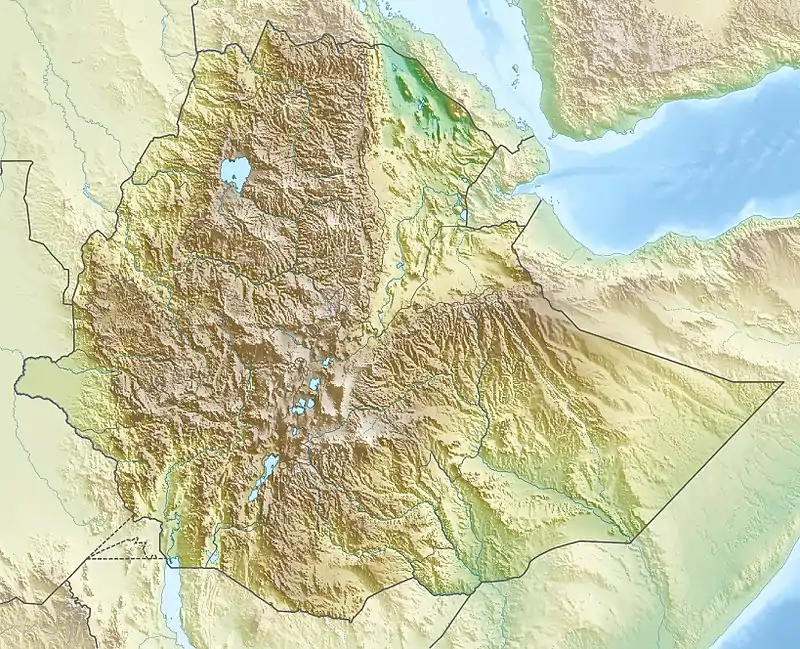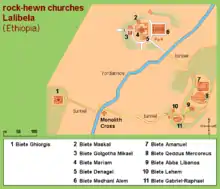Rock-Hewn Churches, Lalibela
The Rock-hewn Churches of Lalibela are monolithic churches located in the Western Ethiopian Highlands near the town of Lalibela, named after the late-12th and early-13th century King Gebre Mesqel Lalibela of the Zagwe Dynasty, who commissioned the massive building project of 11 rock-hewn churches to recreate the holy city of Jerusalem in his own kingdom. The site remains in use by the Ethiopian Orthodox Christian Church to this day, and it remains an important place of pilgrimage for Ethiopian Orthodox worshipers.[1]
| UNESCO World Heritage Site | |
|---|---|
 The Church of Saint George, showing its base and walls | |
| Criteria | Cultural: i, ii, iii |
| Reference | 18 |
| Inscription | 1978 (2nd session) |
| Coordinates | 12°01′57″N 39°02′36″E |
 Location in Ethiopia | |

Archaeological site

The altitude is around 2,480m.[2] The archaeological site consists of 3 sections: the northwestern group, the southwestern group, and Biete Giorgis.
Northwestern group

This group consists of Biete Medhane Alem, Biete Maryam, Biete Golgotha Mikael, Biete Meskel, and Biete Denagel, which are connected to each other by systems of tunnels and trenches.[1]
Southeastern group
Like the Northeastern group, the collection of churches to the southeast, consisting of Biete Amanuel, Biete Qeddus Mercoreus, Biete Abba Libanos, Biete Lehem, and Biete Gabriel-Rufael, are also connected by a system of tunnels.[1]
History
Aksumite Empire
The churches of Lalibela were preceded by the Kedemit Mikael, believed by local tradition to be the first Christian church built in the area. It was commissioned by Aksumite King Kaleb sometime after he founded the city of Roha in the 6th century AD.[2][3]
Zagwe Dynasty
According to local tradition, the churches are said to have been built during the Zagwe Dynasty and under the rule of King Gebre Mesqel Lalibela[4] (r. ca. 1189-1227AD),[5] although it is more likely that they evolved into their current form over the course of several phases of construction and alteration of preexisting structures.[6]
20th century
The site of the rock-hewn churches of Lalibela was first included on the UNESCO World Heritage List in 1978.[7]
Religious significance and function
The Churches of Lalibela hold important religious significance for Ethiopian Orthodox Christians as together they form a pilgrimage site with particular spiritual and symbolic value with a layout representing the holy city of Jerusalem. The site continues to be used for daily worship and prayer, the celebration of religious festivals like Genna,[4][2] as a home to clergy,[4] and as a place which increasingly brings together religious adherents and leaders every year.[2]
Architecture
The churches are each unique, giving the site an architectural diversity that is evident by the human figures of bas-reliefs inside Bet Golgotha; and the colorful paintings of geometrical designs and biblical scenes in Bet Mariam.[4]
Moldings and string courses divide larger structural shapes into smaller sections in many of the churches.[4]
Construction
The construction of the churches are thought to have taken place in 3 phases.[5]
All 11 churches were the result of a process using the basic tools of hammers and chisels to excavate trenches surrounding the monolithic and semi-monolithic structures as well as a system of tunnels which connected two separate groups of the churches with each other out of the scoriaceous basalt.[1][8] The "construction" was done from top to down.
Conservation
Difficulties with conservation from 2000s-onward
Several recent conservation and restoration projects have been implemented at the site, but have been flawed in execution. A project in which the American Embassy is funding the restoration of Bet Gabriel-Rafael and subsequently Bet Golgotha-Mikael has seen issues emerge between the various parties involved in the project regarding understanding of its full scope. There has been a lack of adequate communication and sharing of information regarding project plans between the Authority for Research and Conservation of Cultural Heritage (ARCCH) and the local committee and church.[9]
With funding from the EU, four shelters were erected in 2008 to cover 5 of the site's churches in an attempt to provide a temporary mode of protection for the structures until a more long-term solution could be decided upon.[10] However, the shelters have remained in place now for far longer than they were meant to stay standing, and now consequently pose serious dangers to the buildings underneath as they threaten to collapse due to their heavy weight among other factors. The ARCCH Director has indicated that the shelters must be removed, however there are not yet any definitive plans in place for their removal and what will be done afterward.[9]
References
- Williams, Frances M. (2016-03-21). Understanding Ethiopia : geology and scenery. Cham. ISBN 9783319021805. OCLC 945445084.
- ARCCH, 2013, A Management Plan for the Rock-hewn Churches of Lalibela World Heritage Site Ethiopia, December, Addis Ababa: ARCCH.
- Heritage, Tourism, and Urbanization: The Landscape and Development of Lalibela, Ethiopia. the Trustees of Columbia University of the City of New York. 2017. ISBN 978-0-9882675-3-4.
- Windmuller-Luna, Kristen (September 2014). "The Rock-hewn Churches of Lalibela". Metropolitan Museum of Art. Retrieved 2 May 2019.
- Sani, Frederico (June 2012). "Integrated geological-architectural pilot study of the Biet Gabriel-Rafael rock hewn church in Lalibela, northern Ethiopia". Italian Journal of Geosciences. 131: 171–186 – via ResearchGate.
- Fauvelle-Aymar, François-Xavier; Bruxelles, Laurent; Mensan, Romain; Bosc-Tiessé, Claire; Derat, Marie-Laure; Fritsch, Emmanuel (2010-12-01). "Rock-cut stratigraphy: sequencing the Lalibela churches". Antiquity. 84 (326): 1135–1150. doi:10.1017/S0003598X00067132. ISSN 0003-598X.
- UNESCO, 2006, Report on the Mission to Rock Hewn Churches Lalibela, (Ethiopia): assessment of the planned project “Temporary shelters for five churches in Lalibela”, funded by the European Union. Paris: UNESCO.
- Bosc-Tiessé, Claire; Fauvelle, François-Xavier; Bruxelles, Laurent; Derat, Marie-Laure; Gleize, Yves; Mensan, Romain (2014-11-01). "The Lalibela Rock Hewn Site and its Landscape (Ethiopia): An Archaeological Analysis". Journal of African Archaeology. 12 (2): 141–164. doi:10.3213/2191-5784-10261. ISSN 1612-1651.
- Woldeyes, Y. G. (2018). Conservation Concerns for the Lalibela Rock Hewn Churches. Preliminary Report: Conservation Concerns for the Lalibela Rock Hewn Churches.
- 1 Report of the UNESCO/ICOMOS/ICCROM Advisory mission to Rock-Hewn Churches, Lalibela (Ethiopia) 4